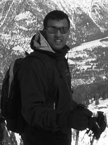DATE: Wednesday,
March 1, 2006
TIME: 12:30 pm - 5:30 pm
PLACE: CIC 410, Intel Conference Room
SPEAKERS:
Lunch available Mary Baker, HP Labs, Palo Alto
Long-term Digital PreservationNigel Davies, Lancaster University, UK
Experiences of Engineering the e-Campus Pervasive Display SystemDushyanth Narayanan, Microsoft Research, Cambridge, UK
Seaweed: Scalable Distributed QueryingDavid Kotz, Institute for Security Technology Studies, Dartmouth College
Sensing, Modeling, and Predicting MobilityMark Corner, University of Massachusetts-Amherst
Hierarchical Power ManagementAntonio Krüger, Institute for Geoinformatics, University of Münster, Germany
Navigating Indoor Spaces
 SPEAKER:
Mary Baker, HP Labs, Palo
Alto
SPEAKER:
Mary Baker, HP Labs, Palo
Alto
Long-term Digital Preservation
The computer industry
has successfully provided many tools for creating the digital counterparts
of formerly analog assets, including photographs, music, movies, medical
records, and intelligence data. One of the promises of this digital world
is that these virtual assets can "live forever." Unfortunately,
experience shows us that digital materials, even those stored on long-lived
media, are often more vulnerable to damage and corruption than analog
materials. Why is this? What can we do about it? In this talk we'll cover
the threats to digital preservation and some of the solutions we're currently
developing.
BIO: Mary Baker is a senior research scientist at HP Labs in Palo Alto. Her research interests include distributed systems, networks, mobile systems and digital preservation. Baker received her BA, MS, and Ph.D. degrees from the University of California at Berkeley. She is a recipient of a Sloan Research Fellowship, a Terman Fellowship, an Okawa Foundation grant, and an NSF Career Award. She was a founding member of the NTT DoCoMo USA Labs technical advisory board and the IEEE Pervasive Computing editorial board.
 SPEAKER:
Nigel Davies, Lancaster University,
UK
SPEAKER:
Nigel Davies, Lancaster University,
UK
Experiences of Engineering the e-Campus Pervasive Display System
The e-Campus project
at Lancaster University is an ambitious attempt to create a campus-wide
deployment of pervasive public displays. These displays range from small
scale interactive door plates to multi-projector outdoor installations.
They are unified by a shared vision of a highly interactive context-aware
display system benefiting both staff and students and displaying rich
"new-media" content. Following a series of small-scale trials
the project is now in the final stages of deployment. In this talk I will
describe our
experiences of creating e-campus installations over the last 2 years and
how these have shaped both the design and implementation of the distributed
systems infrastructure for e-campus and our agenda for future work on
distributed systems platforms for mobile and pervasive computing.
BIO:
Nigel Davies is a Professor in the Computing Department at Lancaster University.
After his studies he served as a visiting researcher at the Swedish Institute
of Computer Science (SICS) before returning to Lancaster in 1994 to help
create the University's Mobile Computing group. He has since managed numerous
projects at Lancaster, including the MOST and GUIDE projects, both of
which have been widely reported on in the academic literature and the
popular press. During 1999/ 2000 he spent a year as a visiting researcher
at Sony's Distributed Systems Lab in San Jose and from 2001-2004 he divided
his time between
Lancaster and Tucson, AZ where he was an Associate Professor at the University
of Arizona. He has participated actively in both the mobile and pervasive
computing research communities and is an Associate Editor in Chief of
IEEE Pervasive Magazine. He works closely with local industry on the commercial
development of mobile computing solutions.
 SPEAKER:
Dushyanth
Narayanan, Microsoft Research, Cambridge, UK
SPEAKER:
Dushyanth
Narayanan, Microsoft Research, Cambridge, UK
Seaweed: Scalable Distributed Querying
Many emerging applications
require the ability to query large, structured, highly distributed data
sets. For example, managers of large data centers may wish to query the
load, the set of running services, the free disk space, etc. across 10,000+
machines. Enterprise network management requires the ability to ask questions
such as "show me the applications running on all machines with more
than 500 active flows" across networks with 100,000+ nodes distributed
across the planet. Internet-scale diagnostic tools such as Dr. Watson
for Windows collect and analyze program crash information over millions
of PCs, but are limited by the amount of data they can upload to a centralized
database.
Seaweed is a new infrastructure aimed at giving users the abstraction of a single centralized database across a large, highly distributed data set. In this talk I will describe the main research challenges involved in building Seaweed and our proposed solutions. Specifically, I will describe a latency-based cost estimation scheme that enables distributed "query planning"; a space-time scheduling approach that predicts and schedules across periods of end-systm unavailability; and a distributed index data structure that trades network bandwidth for latency for by pro-actively aggregating meta-data.
This is joint work with Antony Rowstron, Richard Mortier, and Austin Donnelly at Microsoft Research, Cambridge.
BIO: Dushyanth Narayanan is a systems researcher at Microsoft Research, Cambridge, UK. His current interests are in database performance modelling and large-scale distributed querying. He acquired his Ph.D. from Carnegie Mellon University, where he worked on adaptation in interactive wearable applications. More information about him can be found at http://www.research.microsoft.com/~dnarayan.
 SPEAKER:
David Kotz, Institute for
Security Technology Studies, Dartmouth College
SPEAKER:
David Kotz, Institute for
Security Technology Studies, Dartmouth College
Sensing, Modeling, and Predicting Mobility
Many mobile and pervasive-computing applications depend on
knowledge of user location, to provide location-based services or other
context-aware behavior. The quality of these applications depend on the
system's ability to localize users and user devices, and some depend on
the ability of the system to predict a user's next location. Furthermore,
since many researchers depend on simulation to explore the behavior of
a protocol or system when faced with large numbers of mobile users and
devices, this research depends on the quality of mobility models to accurately
describe realistic mobility patterns. In this talk I describe recent work
in Dartmouth's Center for Mobile Computing aimed at understanding the
accuracy of wardriving to collect the underlying reference points for
Wi-Fi localization, the accuracy of location-prediction algorithms when
faced with real mobility traces, and methods to extract realistic mobility
models from real mobility traces. (Joint work with Minkyong Kim and Libo
Song)
BIO: David Kotz is a Professor of Computer Science at Dartmouth College in Hanover NH. He also serves as the Director of the Center for Mobile Computing, which focuses on wireless networks and mobile computing, and Executive Director of the Institute for Security Technology Studies, which is dedicated to interdisciplinary research and education in cyber security and emergency-response technology. His research interests include security and privacy, pervasive computing, and wireless networks. After receiving his A.B. in Computer Science and Physics from Dartmouth in 1986, he completed his Ph.D in Computer Science from Duke University in 1991 and returned to Dartmouth to join the faculty. He is a Senior Member of the IEEE Computer Society, and a member of the ACM, the USENIX Association, and of Computer Professionals for Social Responsibility. For more information see http://www.cs.dartmouth.edu/~dfk/.
 SPEAKER:
Mark Corner, University of
Massachusetts-Amherst
SPEAKER:
Mark Corner, University of
Massachusetts-Amherst
Hierarchical Power Management
The ease of deployment of wireless and mobile systems is pushing
the network edge far from powered infrastructures. Providing always-on
functionality in such systems can be extremely energy intensive so it
is crucial that they conserve power--increased consumption translates
into a larger battery or a shorter lifetime. This talk presents a technique,
called Hierarchical Power Management (HPM), that addresses this tension.
HPM reduces the energy usage of a system by combining high-power, resource-rich
platforms with low-power, resource-constrained platforms. The low-power
platforms can remain always-on to receive, buffer, and filter requests
from the network while the high-power platforms remain in power-saving
modes. To maximize the amount of time the high-power platform remains
suspended, the low-power platforms delay execution of requests, cache
recent results, and perform tasks locally when possible. We present two
prototype instances of this technique: the Turducken laptop and the Triage
microserver. We also show results that demonstrate substantial energy
savings, leading to battery lifetimes five times longer than current designs.
BIO:
Mark Corner has been an Assistant Professor in the Computer Science Department
at the University of Massachusetts-Amherst since 2003 after graduating
with his PhD in Electrical Engineering from the University of Michigan.
His primary interests lie in the areas of mobile and pervasive computing,
networking, file systems and security. He was the recipient of an NSF
CAREER award in 2005, a Best Paper at ACM
Multimedia 2005, as well as the Best Student Paper Award at Mobicom 2002.
Prof. Corner's work is supported by the NSF, DARPA, and the NSA.
 SPEAKER:
Antonio Krüger, Institute
for Geoinformatics, University of Münster, Germany
SPEAKER:
Antonio Krüger, Institute
for Geoinformatics, University of Münster, Germany
Navigating Indoor Spaces
In this talk I will discuss research on human-computer interaction
paradigms in the context of spatially aware systems, that provide assistance
in instrumented buildings. The talk will focus on our recent advances
the context of indoor pedestrian navigation systems that make use both
of user instrumentation and instrumentation of the environment. I will
also discuss more general systems that provide useful information to users
of indoor spaces (such as a complex office building or retail stores)
as well as allow for multi-modal interaction through speech and gestures.
Beside presenting different technologies that can be used to build such
prototypes, I will also discuss how we have tried to evaluate our prototypes
both in the lab and in the field.
BIO:
My research interest covers different areas of Intelligent User Interfaces.
I am investigating how mobile and ubiquitous computing technology can
help users to effectively carry out their tasks in their spatial environments.
For this purpose we are developing concepts that make use of multiple
input and output modalities (speech, graphics, gestures and interface
agents) to allow users to communicate with private and public devices
in the environment. At the moment we are concentrating our efforts on
several application areas, i.e. pedestrian navigation, museum guides and
shopping assistants. See
http://ifgi.uni-muenster.de/~kruegera/
for more details.
Visitor Coordinator: Tracy Farbacher, tracyf@cs.cmu.edu
For Further Seminar Info Contact:
or visit http://www.pdl.cmu.edu/SDI/
